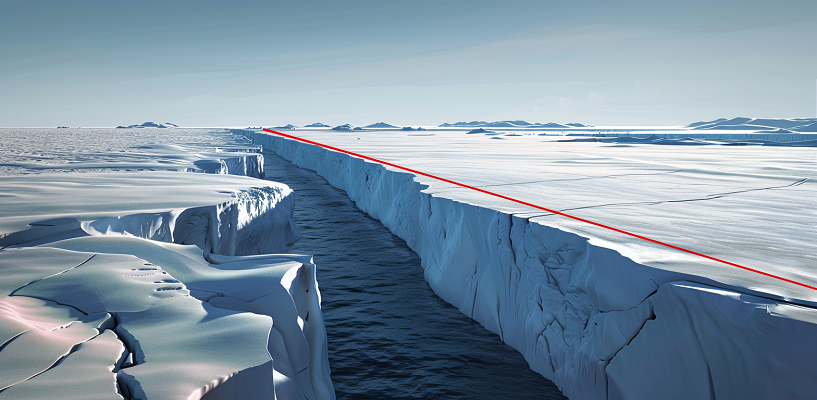Doomsday Glacier

Thwaites Glacier named in honour of the late Fredrik T. Thwaites, an American glaciologist. A glacier is a substantial body of ice that develops on land as a result of long-term snowfall and compaction.
“The extraordinarily vast and broad Doomsday/Thwaites Glacier in Antarctica is located east of Mount Murphy on the Walgreen Coast of Marie Byrd Land. In the vicinity of its grounding line (where the ice first meets the seawater), the glacier flows into Pine Island Bay, which is a portion of the Amundsen Sea, at surface speeds that surpass 2 km per year. It has been said that Pine Island Glacier and Thwaites comprise the “weak underbelly” of the West Antarctic Ice Sheet.” — as stated on “thwaitesglacier.org”. Google Map.
The US McMurdo Research Station and the UK’s Rothera Research Station are almost equal distances apart from Thwaites Glacier.
Working together, the two biggest funding organisations for Earth science, the UK’s Natural Environment Research Council (NERC) and the US’s National Science Foundation (NSF), are examining one of Antarctica’s most susceptible glaciers. A five-year, $50 million joint U.S. and U.K. endeavour. Research on Doomsday/Thwaites Glacier and the surrounding oceanic region is covered by the International Thwaites Glacier Collaboration (ITGC), a collaboration between NERC and NSF.
The “US Antarctic Program’s McMurdo Station” and the “British Antarctic Survey’s Rothera Research Station” are both over 1600 km from the study spots on the Thwaites. People and equipment had to be transported to the field locations, which was done by utilising a variety of aircraft and specialty tractors known as traverses.
It’s challenging to reach into the depth of Thwaites Glacier. So, RAN was designed to carry out extended operations under 200–500 metres of thick ice. RAN is an autonomous underwater vehicle (AUV) that is 7 metres long, a vibrant orange, and is a highly valued part of the ITGC.
Doomsday Glacier Flows Into -
Among the largest five glaciers in Antarctica are Pine Island and Thwaites, both of which flow into the Amundsen Sea. Together, the two ice flows drain around 5% of the Antarctic Ice Sheet. According to research, these glaciers began to flow more readily in the middle of the 2000s. If they melted totally, sea levels would rise by 3.0–6.2 feet.
The volume of ice streaming out of the Thwaites 120-kilometer-wide region has almost doubled during the last 30 years. The ice melts due to the circulation of warm ocean water from the Amundsen Sea beneath it. Warm water has moved to 14 km beneath since 1992.
Each of the ITGC projects, GHOST, TIME, MELT, and TARSAN, are concerned with the natural mechanisms that cause the glacier to retreat or control its reaction to climate change.
Doomsday Glacier Size -
“With a surface size of 192,000 square-km, Doomsday/Thwaites Glacier is the largest glacier in the entire globe. As a result, it is somewhat smaller than the whole island of Great Britain (209,000 square-km) and bigger than the US state of Florida (170,000 square-km). With an ice thickness ranging from 800 to 1,200 metres from bedrock to surface, it is likewise incredibly tall.” — as stated on “thwaitesglacier.org”.
Massive areas of sea ice that are permanently floating slightly offshore are known as ice shelves, and they are frequently seen near Antarctic glaciers. The ice shelves serve to stabilise the glacier. It is positioned between the grounded ice on land (glacier) and the sea water. In essence, the ice shelf is an extension of the glacier or ice sheet that floats on the ocean’s surface.
“Researchers found that the ice wasn’t always covering the rocks (they had taken from Thwaites). The ice sheet surrounding Doomsday/Thwaites Glacier was at least 35 metres thinner ‘5000 years ago’ than it is today. It has taken at least 3,000 years for the ice sheet to expand to its current size since that time. This finding demonstrates that ice sheet retreat in the Thwaites Glacier region can be decreased.” — as stated on “thwaitesglacier.org” under the news “Rocks beneath Antarctic …”.
Doomsday Glacier Melting ? -
“Two kilometres from the Doomsday/Thwaites Glacier grounding line, in a 600-meter-deep borehole, a team of scientists and engineers positioned a robot named Icefin. The ocean along the grounding line was discovered to be extremely warm and salted, although the average annual melt rate along the ice base was found to be between 2 and 5 metres. They discovered that the ice shelf’s base is covered with crevasses and stair-like formations called “terraces,” which are melting more quickly. Heat and salt can be carried into the ice by the flowing water through these uneven formations, expanding the rifts and crevasses.” — as stated on “thwaitesglacier.org” under the news “Dr Peter Davis and Dr Britney Schmidt …”.
“2014 saw the discovery that the region beneath Thwaites Glacier had heat flow from geothermal activity that was almost twice as high as the global average and roughly 3.5 times larger in hotspots.” — as stated on “phys.org”.
“By 2017, it was discovered that there is about one volcano for every 11,200 square-km in Marie Byrd Land, which is home to Thwaites and Pine Island Glaciers. Due to the comparatively high density, melting may be impacted by the heat from magma flows under these volcanoes.” — as stated on “sciencedirect.com” and “ncbi.nlm.nih.gov”. “Further, as more ice vanishes as a result of isostatic rebound, the likelihood of volcanic eruptions rises.” — as stated on “geoscienceworld.org“.
“Doomsday/Thwaites Glacier underwent a net loss of nearly 600 billion tonnes of ice between 1992 and 2017 (i.e., with an annual loss of 0.3 to 0.8 km length, depending on the region).” — as stated on “nytimes.com” and “science.org”. During that time, this loss was responsible for almost 4% of the rise in sea level worldwide.
“Between 2002 and 2016, the total annual loss of ice rose significantly from roughly ‘16 billion tonnes between 1992 and 1996’ to about 50 billion tonnes. Over these 14 years, the total amount of ice lost was equal to a 2.07 mm (0.009 feet) rise in sea level worldwide. The Amundsen Sea Low (ASL), winds, calving fronts, snow, and Circumpolar Deep Water (CDW) are some of the variables that impact the glacier.” — as stated on “thwaitesglacier.org”.
“Subsequent examination of data of glaciology journals indicated that bottom-up melting of Thwaites would accelerate annually by 1 m with every 0.1 °C rise in ocean temperature.” — as stated on “escholarship.org“.
In January 2019, NASA found an underwater hollow situated beneath the glacier that encompassed an area equivalent to two-thirds of Manhattan.
“The unusual change is being driven by warming oceanic and atmospheric temperatures and their interactions with glaciers.” — as stated on “sciencedirect.com” under the article “How much, how fast? …”.
That’s all friends.

